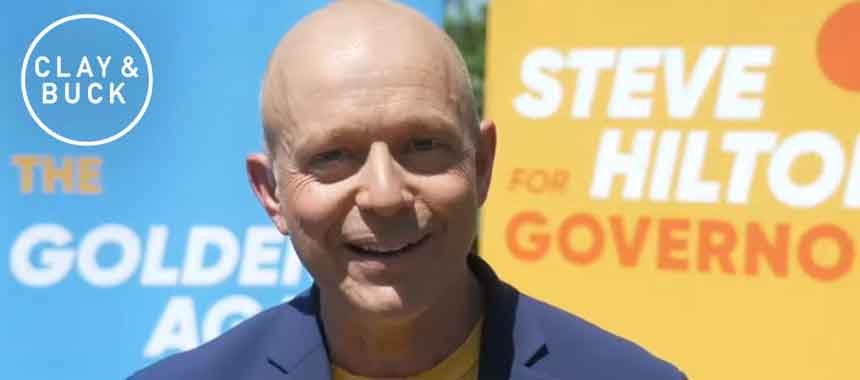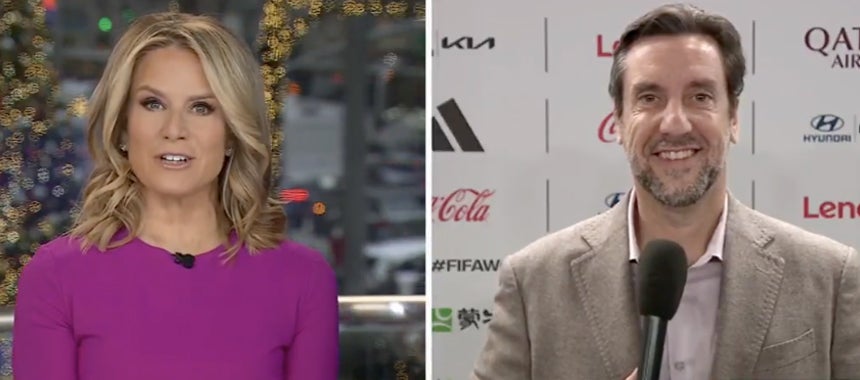Econ Icon Art Laffer’s Master Class on Inflation and Recession
21 Jul 2022
BUCK: The economy is important to all of us, and certainly going to play a massive role in the upcoming election in just a few months now. We want to bring on somebody who is legendary in the space. Even does get a shout-out in the fantastic “Ferris Bueller’s Day Off” for his amazing curve. Art Laffer. The Laffer Curve. Former Reagan economic adviser is with us now. Art, great to talk with you, sir.
LAFFER: Thank you very much. My pleasure. My pleasure.
BUCK: Start with the big ones, and we’ll work down into some of the specifics here, Art. Are we in a recession? How bad is it going to get?
LAFFER: Well, Citicorp today said that their expectation was a 50 percent chance of getting in a recession. And my comment on that was, we had the first quarter was down GDP, 1.6 percent. The second quarter is already over. And the estimates are it’s going to be down one and a half percent. Which means, we’re already in a recession. How long they say it’s a 50 percent chance, when it’s already happening? And we’ve been in one. Now, the only question is really, how long is it going to last, and how bad is it going to be?
CLAY: Art, where would we be — first of all, thanks for coming on.
LAFFER: My pleasure.
CLAY: Second, where would we be, if the Democrats had been able to pass their Build Back Better, multi-trillion-dollar expenditures in terms of inflation, in your mind? We’re at 9.1 percent right now opinion do you think that inflation is going to get worse? How much worse do you think it might have been, if Biden had gotten his way, and had gotten Build Back Better past?
LAFFER: Well, in the first place, I do think that it’s going to get worse. And I think it’s going to get a good deal worse.
CLAY: How much worse? Because it’s pretty bad right now. You say it’s going to get worse.
LAFFER: Not really. You know, the next three numbers. Let me do inflation with you for a second, first. Just to see it. Inflation is the percent change in the consumer pricings from a year ago. So it’s an annual change in the percentage change in the CPI, consumer price index. Now, every month, we get a new no one. Which means we drop off one month a year ago. And we add a new month on, now. The numbers we have been dropping off, over the last four months, have been very, very large numbers, which means that the new numbers have even been larger for that thing to increase. It’s really amazing. I would have little the inflation rate would have dropped. Now, the next three months, the numbers dropped off are really small, are very, very small. So even modest numbers on inflation are going to pop us up over 10% over the next three months. So coming into the election, I would expect inflation numbers to be above 10%.
BUCK: Speaking to Art Laffer, former Reagan economic adviser. Art, I have a question, that I keep posing to people. And I hear all these different explanations. I really wanted to hear this from you, because one of the things the Biden White House talks about a lot. They’ll say the unemployment rate is so low. So things are good. You just don’t know it. Yeah. Gas is expensive, and so is your food and so is everything else, and inflation is a problem. But look at how good the unemployment rate is. That’s one part of this. But then even more specifically, I come across businesses, and have talked to business owners, who keep saying, it’s really hard to find people to take jobs. Restaurants. And stores. This seems to be happening in different parts of the country. Across the country though, what is going on there?

LAFFER: Well, it’s very, very simple. The unemployment rate is very, very low. Yes, therefore very few people available to take jobs. There are lots of job openings for a number of people. But one of the things you have to add into that is that the employment rate is very, very low. The employment rate has dropped huge amounts to where it’s a little over 62 percent. All of this means is one thing. Lots and lots and lots of potential workers have left the labor force, and are no included in the employment rate and/or the unemployment rate. So what’s happening, is workers have just left the labor force because they were given enough money to not go back to their job that they didn’t like. So we have a huge reduction in total employment, a reduction in the number of unemployed, a nd also, a lot of new jobs.
CLAY: You said 62%. What would be the standard number?
LAFFER: Well, let’s say back to Clinton it was 68, 69%.
BUCK: Got you.
LAFFER: Now, that’s seven times, what? A million and a half, a million 6, 106 — 60 million, something like that. So you’re talking 11, 12 million people have left the labor force.
BUCK: Wow.
CLAY: Art.
LAFFER: That’s a lot of people.
CLAY: You have been talking about the impact that covid had and our response to it for a while. So I want to give you kind of a two-parter here. One, going back to the question, Build Back Better passes, you say you think we’ll be over 10 percent in the next two months running into the election. What do you think it would have been if Biden had gotten his economic agenda in place? And as you now have a couple of years of data to look bang over how we responded to covid, building off of that, how much of a disaster from a pure economic perspective, you were the policies that we embraced associated with covid?
LAFFER: Well, let me just say, number one, if the Build Back Better had passed, depending on how they rolled it out, we would have a lot higher inflation rate, a lot higher debt-to-GDP ratio, and the economy would be in a lot worse shape than it is right now. That’s number one. There would be a lot less people working, either employment or unemployment. It would have been a major reduction in output and also a major increase in the rate of inflation. That’s what would have happened, if we had Build Back Better. And it would have been rolled out over a long period of time, so this would continue for several years from now. That’s true.
Now, the covid thing. The one thing I liked on covid. As you probably know, I spent a lot of time with the president on covid. And he did one thing that was amazing, was the development of the vaccine. His his efforts to to get that vaccine were wonderful. He spared no expense. And we got a vaccine in less than a year. Which was just unheard of. That was the most amazing thing. Everything on covid should not have been done. It was a tragedy, covid. Everyone got hurt. But any of this, trying to alleviate the pain by redistributing income makes no sense whatsoever.
 BUCK: Art, I like to try to focus on the optimistic side of things if I can. It’s hard to be optimistic about where this economy seems to be going, especially given the people who are pulling the levers, whether it’s at the White House, Treasury, and the Fed. You said, we’re in a recession. Clay and I have been saying that for months, just because it’s pretty apparent to everyone paying attention, we’re already in a recession. But it could be six months. It could be three or four years. Right? For us to actually turn this thing around.
BUCK: Art, I like to try to focus on the optimistic side of things if I can. It’s hard to be optimistic about where this economy seems to be going, especially given the people who are pulling the levers, whether it’s at the White House, Treasury, and the Fed. You said, we’re in a recession. Clay and I have been saying that for months, just because it’s pretty apparent to everyone paying attention, we’re already in a recession. But it could be six months. It could be three or four years. Right? For us to actually turn this thing around.
LAFFER: Some of these last a long time. You know, the stock market, in February of ’66 was at 1,000. And inflation adjusted in August of 1982, it was at 235. So the value of the stock market, in real terms, fell by 76 and a half percent 16 and a half years. That’s a bear market. And, you know, those things are not impossible. And we have the worst government today, than we’ve ever had.
BUCK: So what does it look like, though, if you’re looking for indicators for the folks out there, that not only are we having this inflation, and, you know, you explained why the jobs numbers aren’t really reflective of the health of the economy right now. What do you see on the front page of the Wall Street Journal, or, you know, popping up on CBS, and you go, oh, this is going to get ugly.
LAFFER: Yeah. Well, let me tell you what I look at opinion and why I can be a little optimistic. I don’t like to be optimistic or pessimistic, Buck. I like to really be realistic. Tax rates are low. Thirty-seven percent. These guys were not able to roll back the Trump tax cuts. All of that, which means that the economy could really do a lot better than it would have done, let’s say during the ’70s, and ’60s late ’60s. So I’m much more optimistic because of tax rates. We never went babbling to the 70, 80, 90 percent tax rates. And that’s a big blessing.
We have a huge debt overload, which makes it a lot worse than it was back then. So here we are, in a world, where we have a lot of conflicting things. But my view is, I think the economy is in rough shape, unless we win the elections in November. And then win them again in November of ’24. We really need to change policies, change direction, and change the incentive structure, dramatically.
CLAY: Art, you’re way smarter obviously than either Buck or I, in analyzing the economic situation. And Buck and I have been talking off air and I’m curious if you could explain it to me in a way that our audience can understand and I can understand. Despite that our economy certainly appears to be in a very challenging time, the dollar has been skyrocketing in value against virtually every other global currency out there. Recently achieved parity with the euro, which hadn’t happened in roughly 20 years. What is going on, that we’re seeing a flight into the dollar, such that the dollar is increasing in value, against virtually every other currency around the world.
LAFFER: Yeah. There’s three measures of the value of a dollar. You can measure it in terms of eggs. You can measure it in terms of shoes. You can measure it in terms of gold. You can measure it in terms of foreign exchange. Or you can measure it in terms of goods and services. The dollar is really strong in comparison to other currencies, the dollar has even improved relative to gold. But relative to goods and services, the dollar is in terrible shape. You know, being short myself, the way I like to say it, is the dollar is the tallest midget in the group. And, you know, all currencies worldwide are in really bad shape. And the dollar is just the least bad of those currencies.

BUCK: If you could get the Biden administration — back to your realism tinged with optimism, perhaps. We’re speaking to Art Laffer, everybody, the legendary economist. Reagan’s adviser on the economy, advised Trump on the economy, during covid. Art, let’s just assume for a second, you know, we’re doing a talk show here. If you could sit down with Biden after the midterms, after the utter butt kicking that we hope and we believe is coming in the Congress for the Democrats. And Biden was willing to listen to you on a thing or two. Right? He’s not going to do everything, but on a thing or two. What would you say, please just do this, because you will see the benefits for the American people?
LAFFER: Well, let me start off by saying, how do you reduce the price of apples? If you look at the marketplace in and how do we get apples prices to fall. Well, there are two ways you can get apple prices to fall. One, you can get people to demand less apples, and if there’s less demand for apples, the price of apples will fall, as we move downward on the supply curve. Are you with me?
CLAY: Yes, sir.
LAFFER: There’s another way to get the price of apples to fall is to have a bumper crop of apples, to have a huge increase in the supply of apples and then we move down along the demand curve and the price of apples falls. One way is to crush demand, the other way is to enhance supply.
My view is , as opposed to Larry Summers, and other Keynesian economists is I like to see us reduce inflation by increasing the supply of goods and services, which would naturally help bring down the price of goods and services. That’s number one.
Number two, the currency. You need to have a tight money policy. Inflation is basically too much money, chasing too few goods. As I said I’d like to increase the supply of goods to make more goods and also to reduce the supply of money or make the demand for money there, which means you have to stop trying to control interest rates. And let interest rates seek their own level in the marketplace. With inflation running at 9.1 percent, how in the heck, Clay — how in the heck is it possible, that we have a ten-year bond yield of around 3% percent? Would you buy a government bond at 3%? With your money?
BUCK: No.
CLAY: That’s one of the questions that we both have in general about the way that mortgage rates are going. That leaves me, Art — you’re awesome on all this stuff, by the way. Even people who are not Nobel Prize winning economists, can understand basically as you work through here. We’re at 9.1 persuasive inflation. You think we’re going over 10% by the midterms.
LAFFER: Oh, you know, there’s nothing I see that will stop inflation any time soon.
CLAY: That is my question. For everybody out there, dealing with the ravages of inflation. How long is it going to be until there is some normalcy in terms of inflation?
LAFFER: Well, I have no idea. It depends on what the fed does. If the fed lets interest rates stay below the rate of inflation, it could last forever.
CLAY: Yeah.
LAFFER: If they keep printing more money. Now, when you look at it. M1, the money supply is the share of GDP, has increased fourfold in the last two, three years. Hello! You’ve got a huge increase in the amount of money and liquidity and there’s no controls there. And you’re contradicting the supply of goods and services. You know, it makes no sense whatsoever. If those policies are continued, you could just see that inflation going on and on and on.
 Now, I lived through the ’70s and the ’80s. And we had two sets of policies that brought it under control. Paul Volcker allowed interest B rates to radio rise. I think interest rates were at 15, 16, 17 percent when the inflation rates were in the low teens and that really made it tight money. Then we had the tax cuts, which increased the supply of goods and services under Reagan, and if you look at that inflation, it felt like a stone. It just came straight down. And that’s exactly what we have to do now.
Now, I lived through the ’70s and the ’80s. And we had two sets of policies that brought it under control. Paul Volcker allowed interest B rates to radio rise. I think interest rates were at 15, 16, 17 percent when the inflation rates were in the low teens and that really made it tight money. Then we had the tax cuts, which increased the supply of goods and services under Reagan, and if you look at that inflation, it felt like a stone. It just came straight down. And that’s exactly what we have to do now.
But, you know, there is no talent on the Federal Reserve board today. They’re picked for all sorts of characteristics, other than being competent in fed policy. And I don’t see them having the wherewithal or even the knowledge to be able to choose a good answer. They just don’t know. Of these are not prevails. This is not Paul Volcker. It’s not Alan Greenspan. It’s not Arthur Burns. It’s not McChesney Martin. These are people selected because of their gender or whatever it may be. And they’re realizing something very serious. And they don’t have the wherewithal to do it.
BUCK: Art Laffer, everybody. Clay, I’m going to copy your notes after class today. Okay?
CLAY: Yeah. I’m not kidding. This is amazing. First of all, thank you for the time.
LAFFER: My pleasure.
CLAY: I hope people enjoyed this as much as Buck and I did. Because it does feel like you get to sit with — it’s like you’re in economics class.
BUCK: Feel like I have to go home right now and study, like do some homework.
CLAY: Oh, he’s awesome.
Recent Stories

Clay Calls in from Spectacular FIFA Event at the Kennedy Center
Clay is with President Trump for a memorable honor where Trump received a FIFA Peace Prize.

Isabel Brown Tells Us the Story of Tangling with the Communists on CNN
The Daily Wire host also talks the spiritual crisis Gen Z is trying to correct.

Steve Hilton's Plan to Clean Up California Corruption
California Gubernatorial Candidate Steve Hilton joins Buck to discuss what he says is the unparalleled corruption in California.

Markwayne Mullin Talks Venezuela Strikes, the Meat Industry -- and Trump's FIFA Peace Prize
The Oklahoma senator tackles big issues with Buck.

Clay Sheds Light on FIFA Draw & Politics
Miss Clay on The Story with Martha MacCallum? Watch it here.





